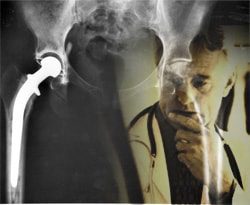
The U.S. Food & Drug Administration’s (FDA) metal-on-metal hip replacement investigation is flawed, according to researchers. Last year, the agency ordered makers of the all-metal devices to conduct post-marketing studies into their safety. The studies have been slow to implement and “methodologic issues will limit the usefulness of the information that emerges from these studies,” […]
 The U.S. Food & Drug Administration’s (FDA) metal-on-metal hip replacement investigation is flawed, according to researchers.
The U.S. Food & Drug Administration’s (FDA) metal-on-metal hip replacement investigation is flawed, according to researchers.
Last year, the agency ordered makers of the all-metal devices to conduct post-marketing studies into their safety. The studies have been slow to implement and “methodologic issues will limit the usefulness of the information that emerges from these studies,” wrote Joshua Rising, MD, MPH, of the Pew Charitable Trusts in Washington, D.C., and two colleagues. Their findings appear online in a New England Journal of Medicine Perspective article, said MedPage Today.
The team also warns that the studies will not be as useful as they could be if the FDA does not change its approach and noted that the protocols for less than 25% of the 104 devices covered by the agency’s order had been approved and that 80 products were listed in the FDA’s study plans as either “pending” or “overdue,” said MedPage Today. In fact, for those that had been approved, the team stated, “it was unclear whether any studies had begun.”
The group also cited issues with the FDA’s requirements for the studies, which it described as being excessively loose, said MedPage Today. “One significant shortcoming is that each manufacturer is permitted to conduct its own independent study on its product or products. The resulting lack of harmonization among studies will lead to challenges in pooling the data and making cross-product comparisons,” the group wrote.
For instance, they said, the agency has no specifications as to how firms should measure chromium and cobalt ions in blood, a critical marker for metal-on-metal implant dysfunction. The variance that will occur, they said, will “introduce uncertainty into attempts to pool results,” wrote MedPage Today. The team also expressed concern that the FDA has no authority to mandate such post-marketing studies to extend beyond three years, which might not allow sufficient time to judge devices touted as lasting 15 years, said MedPage Today.
Nearly 16,000 adverse events have been linked to the controversial devices in just the United States from 2000 to 2011, according to regulators, said NJ.com. The reports nearly quadrupled in 2008 to 682 from the prior year, experiencing a rise following Johnson & Johnson’s DePuy unit’s 2010 recall of 93,000 ASR devices globally; one-third of these were recalled in the United States. In 2011, adverse event reports totaled 12,137 for the metal-on-metal devices, versus 6,332 linked to other hip implant types, according to the FDA. More than 12% of the devices failed within the first five years of implantation.
Today, Johnson & Johnson faces over 6,000 lawsuits in federal and state courts over the devices and related adverse events, including the pain, ambulation issues, the need for revision surgery, increased blood cobalt levels, and pseudotumors, to name just some. The ASR hip devices—9,006 in all—account for 74% of 2011’s incident reports, said the FDA, wrote NJ.com.
Meanwhile, the researchers are calling on the United States to implement device registries, such as those seen in other countries, pointing out that the first warning signs about all-metal hips originated at an Australian agency, said MedPage Today.


